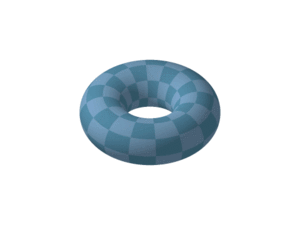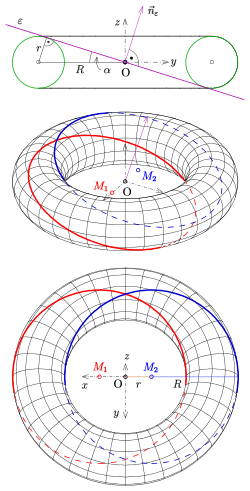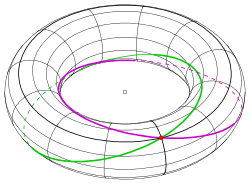Villarceau circles


In geometry, Villarceau circles /viːlɑːrˈsoʊ/ are a pair of circles produced by cutting a torus obliquely through the center at a special angle. Given an arbitrary point on a torus, four circles can be drawn through it. One is in the plane (containing the point) parallel to the equatorial plane of the torus. Another is perpendicular to it. The other two are Villarceau circles. They are named after the French astronomer and mathematician Yvon Villarceau (1813–1883). Mannheim (1903) showed that the Villarceau circles meet all of the parallel circular cross-sections of the torus at the same angle, a result that he said a Colonel Schoelcher had presented at a congress in 1891.
Example
For example, let the torus be given implicitly as the set of points on circles of radius three around points on a circle of radius five in the xy plane
Slicing with the z = 0 plane produces two concentric circles, x2 + y2 = 22 and x2 + y2 = 82. Slicing with the x = 0 plane produces two side-by-side circles, (y − 5)2 + z2 = 32 and (y + 5)2 + z2 = 32.
Two example Villarceau circles can be produced by slicing with the plane 3x = 4z. One is centered at (0, +3, 0) and the other at (0, −3, 0); both have radius five. They can be written in parametric form as
and
The slicing plane is chosen to be tangent to the torus while passing through its center. Here it is tangent at (16⁄5, 0, 12⁄5) and at (−16⁄5, 0, −12⁄5). The angle of slicing is uniquely determined by the dimensions of the chosen torus, and rotating any one such plane around the vertical gives all of them for that torus.
Existence and equations

For the bottom picture the projection is orthogonal onto the section plane. Hence the true shape of the circles appear.


A proof of the circles’ existence can be constructed from the fact that the slicing plane is tangent to the torus at two points. One characterization of a torus is that it is a surface of revolution. Without loss of generality, choose a coordinate system so that the axis of revolution is the z axis. Begin with a circle of radius r in the xz plane, centered at (R, 0, 0).
Sweeping replaces x by (x2 + y2)1/2, and clearing the square root produces a quartic equation.
The cross-section of the swept surface in the xz plane now includes a second circle.
This pair of circles has two common internal tangent lines, with slope at the origin found from the right triangle with hypotenuse R and opposite side r (which has its right angle at the point of tangency). Thus z/x equals ±r / (R2 − r2)1/2, and choosing the plus sign produces the equation of a plane bitangent to the torus.
By symmetry, rotations of this plane around the z axis give all the bitangent planes through the center. (There are also horizontal planes tangent to the top and bottom of the torus, each of which gives a “double circle”, but not Villarceau circles.)
We can calculate the intersection of the plane(s) with the torus analytically, and thus show that the result is a symmetric pair of circles, one of which is a circle of radius R centered at
A treatment along these lines can be found in Coxeter (1969).
A more abstract — and more flexible — approach was described by Hirsch (2002), using algebraic geometry in a projective setting. In the homogeneous quartic equation for the torus,
setting w to zero gives the intersection with the “plane at infinity”, and reduces the equation to
This intersection is a double point, in fact a double point counted twice. Furthermore, it is included in every bitangent plane. The two points of tangency are also double points. Thus the intersection curve, which theory says must be a quartic, contains four double points. But we also know that a quartic with more than three double points must factor (it cannot be irreducible), and by symmetry the factors must be two congruent conics. Hirsch extends this argument to any surface of revolution generated by a conic, and shows that intersection with a bitangent plane must produce two conics of the same type as the generator when the intersection curve is real.
Filling space
The torus plays a central role in the Hopf fibration of the 3-sphere, S3, over the ordinary sphere, S2, which has circles, S1, as fibers. When the 3-sphere is mapped to Euclidean 3-space by stereographic projection, the inverse image of a circle of latitude on S2 under the fiber map is a torus, and the fibers themselves are Villarceau circles. Banchoff (1990) has explored such a torus with computer graphics imagery. One of the unusual facts about the circles is that each links through all the others, not just in its own torus but in the collection filling all of space; Berger (1987) has a discussion and drawing.
See also
References
- Banchoff, Thomas F. (1990). Beyond the Third Dimension. Scientific American Library. ISBN 978-0-7167-5025-3.
- Berger, Marcel (1987). "§18.9: Villarceau circles and parataxy". Geometry II. Springer. pp. 304–305. ISBN 978-3-540-17015-0.
- Coxeter, H. S. M. (1969). Introduction to Geometry (2/e ed.). Wiley. pp. 132–133. ISBN 978-0-471-50458-0.
- Hirsch, Anton (2002). "Extension of the 'Villarceau-Section' to Surfaces of Revolution with a Generating Conic". Journal for Geometry and Graphics. Lemgo, Germany: Heldermann Verlag. 6 (2): 121–132. ISSN 1433-8157.
- Mannheim, M. A. (1903). "Sur le théorème de Schoelcher". Nouvelles Annales de Mathématiques. Paris: Carilian-Gœury et Vor. Dalmont. 4th series, volume 3: 105–107.
- Stachel, Hellmuth (2002). "Remarks on A. Hirsch's Paper concerning Villarceau Sections". Journal for Geometry and Graphics. Lemgo, Germany: Heldermann Verlag. 6 (2): 133–139. ISSN 1433-8157.
- Yvon Villarceau, Antoine Joseph François (1848). "Théorème sur le tore". Nouvelles Annales de Mathématiques. Série 1. Paris: Gauthier-Villars. 7: 345–347. OCLC: 2449182.
External links
| Wikimedia Commons has media related to Villarceau circles. |
- Flat Torus in the Three-Sphere
- (French) The circles of the torus (Les cercles du tore)